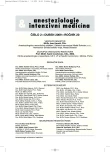Anaphylaxis after induction to general anaesthesia: Four case reports
Authors:
Frančáková Jana; Fiala Hynek
Authors‘ workplace:
Klinika anesteziologie a resuscitace Fakultní nemocnice Olomouc
Published in:
Anest. intenziv. Med., 20, 2009, č. 2, s. 73-77
Category:
Anaesthesiology - Case Report
Overview
Allergic reactions during regional and general anaesthesia represent relatively infrequent but serious complications. Out of the drugs used in anaesthetics, the most common triggers of allergic reactions are muscle relaxants, particularly suxamethonium and rocuronium. Atracurium on the other hand usually causes anaphylactoid reactions. The authors present four case reports illustrating the anaphylactic and anaphylactiod reactions. The pathophysiology, diagnostics and management of serious allergic reactions are discussed. The authors also discuss the preoperative assesment and preparation of allergic patients and the preparation of the anaesthesiologists for managing these complications.
Keywords:
anaphylaxis – muscle relaxants – rocuronium – anaesthesia
Sources
1. Adamus, M., Koutná, J., Neoral, Č. Výskyt pooperační reziduální kurarizace na dospávacím pokoji po aplikaci rokuronia. Rozhl. Chir., 2007, 86, s. 11–16.
2. Adamus, M. Monitorování nervosvalového přenosu v anesteziologii. 1. vyd. Olomouc: Vydavatelství Univerzity Palackého v Olomouci, 2007, 84 s. ISBN 978-80-244-1718-9.
3. Mertes, P. M., Laxenaire, M. C. Anaphylactic and Anaphylactoid Reactions Occurring During Anaesthesia in France. Seventh epidemiologic survey (January 2001-December 2002). Ann. Fr. Anesth. Reanim., 2004, 23, p. 1133–1143.
4. Harboe, T., Guttormsen, A. B., Irgens, A., Dybendal, T., Florvaag, E. Anaphylaxis During Anesthesia in Norway: a 6-year single-center follow-up study. Anesthesiology, 2005, 102, p. 897–903.
5. Fischer, M. M., Baldo B. A. The Incidence and Clinical Features of Anaphylactic Reactions During Anesthesia in Australia. Ann. Fr. Anesth. Reanim., 1993, 12, p. 97–104.
6. Herold, I. Svalová relaxancia v anesteziologii a intenzivní péči. 1. vyd. Praha: Maxdorf Jessenius, 2004, s. 178–182. ISBN 80-7345-025-9.
7. Petrů, V., Krčmová, I. Anafylaktická reakce. 1. vyd. Praha: Maxdorf Jessenius, 2006, 112 s. ISBN 80-7345-099-2.
8. Caughey, G. H. Tryptase Genetics and Anaphylaxis. J. Allergy Clin. Immunol., 2006, 117, p. 1411–1414.
9. Brown, S. G., Blackman, K. E., Stenlake, V., Heddle, R. J. Insect Sting Anaphylaxis; Prospective Evaluation of Treatment with Intravenous Adrenaline and Volume Resuscitation. Emerg. Med. J., 2004, 21, p. 149–154.
10. Bonifazi, F., Jutel, M., Bilò, B. M., Birnbaum, J., Muller, U. Prevention and Treatment of Hymenoptera Venom Allergy: Guidelines for Clinical Practice. Allergy, 2005, 60, p. 1459–1470. Dostupný také na: www.eaaci.net/media/PDF/P/653.pdf.
Labels
Anaesthesiology, Resuscitation and Inten Intensive Care MedicineArticle was published in
Anaesthesiology and Intensive Care Medicine

2009 Issue 2
Most read in this issue
- Anaphylaxis after induction to general anaesthesia: Four case reports
- Erythropoietin and other erythropoiesis-stimulating drugs and bloodless medicine – a new era in the management of anaemia?
- Anterior spinal artery syndrome as a complication of neuroaxial blocade – successful treatment with prostacyclin (case report)
- A fatal complication of tracheostomy in a 13-year-old patient with Duchenne Muscular Dystrophy – case report
